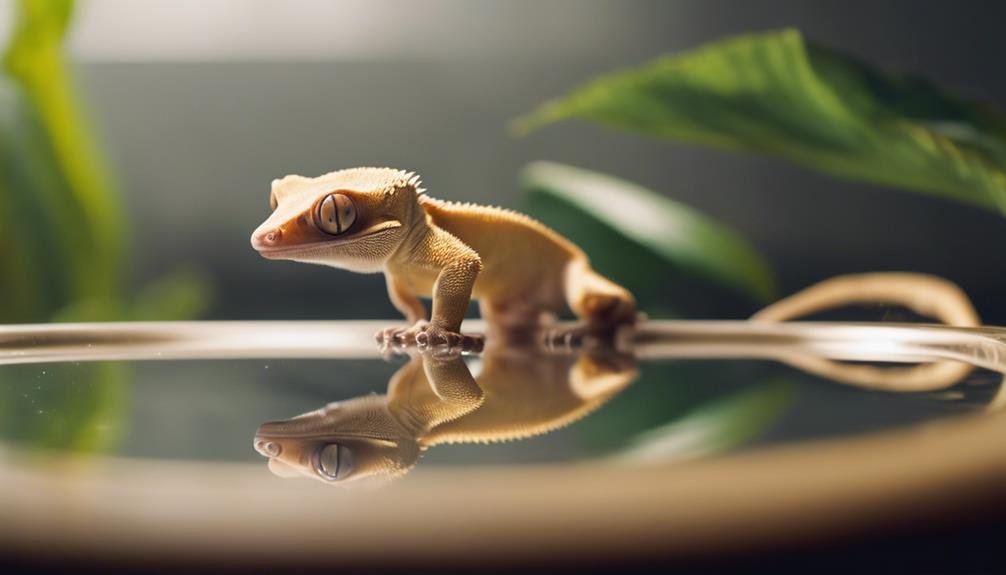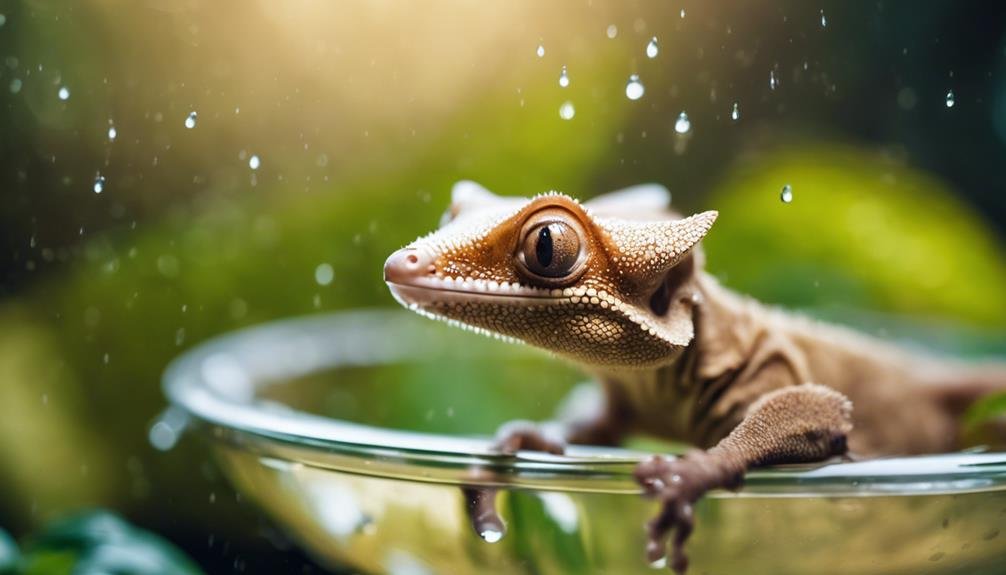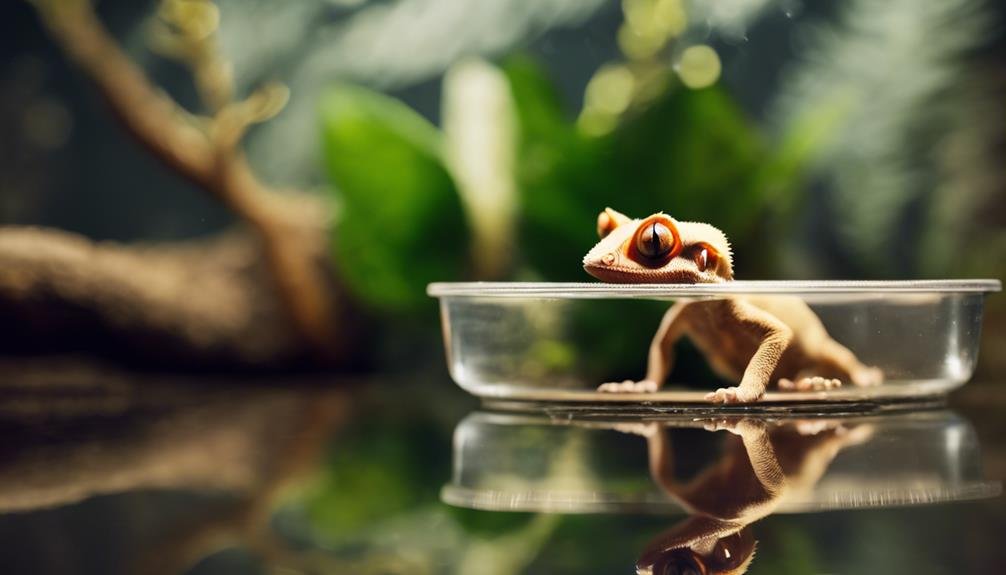You’ve likely pondered whether your crested gecko can swim, especially considering their natural habitat. While they possess the ability to navigate through water, it’s not their preferred activity due to their arboreal lifestyle. Their evolutionary adaptations lean more towards climbing than swimming. However, understanding their swimming mechanics and recognizing the potential risks involved is essential for their care. Ensuring their habitat mimics their natural environment, with safe exit points from water, is key. But how do you properly manage water exposure to keep your gecko both safe and clean? Let’s explore the nuances of balancing their swimming capabilities with their well-being and hygiene needs.
Key Takeaways
- Crested geckos can swim when necessary but are not naturally adept at it due to their arboreal nature.
- They utilize their webbed feet to paddle through water, allowing them to move at a fast pace to exit quickly.
- Swimming can cause stress and poses a drowning risk, as crested geckos cannot breathe underwater.
- Supervision is crucial during swimming to ensure their safety and prevent accidents.
- For hydration, shallow water dishes are preferred, emphasizing the need for safe, stress-free access to water in their habitat.
Crested Geckos & Swimming Ability
Crested geckos can swim when necessary, but they usually avoid water and prefer staying on dry land. Your crested gecko has a built-in survival instinct that kicks in if they find themselves in water. Despite this, swimming isn’t their forte. Unlike their aquatic cousins, these little adventurers can’t breathe underwater, so they’ll be quick to seek an escape route to dry land.
Their swimming ability, while present, is more of an emergency skill rather than a preferred daily activity. You might notice they paddle with their feet in a bid to navigate through water. This is because their webbed feet, although not designed for swimming like those of a duck, offer them a slight edge in maneuvering in water. However, don’t be fooled into thinking they’re as comfortable in water as they’re while scaling the heights of their arboreal habitats. Climbing trees is second nature to them, a stark contrast to the effortful paddles in water.
Swimming Mechanics Explained
Paddling quickly with their webbed feet, crested geckos move through water in a unique way that contrasts sharply with their natural arboreal agility. When you introduce a gecko into the water, you’ll notice they can’t move on the surface like some other geckos. Instead, they may swim at a fast pace, which often signals their desire to exit the water as soon as possible. This quick paddling is part of their swimming mechanics explained.
While they’re capable of floating, crested geckos can’t breathe underwater, emphasizing the need to take care when you bathe your crested gecko or allow it to swim. Close supervision is important to prevent drowning, making it clear that swimming doesn’t come as naturally to them as climbing. Their discomfort with swimming stems from their evolution as tree-dwellers, where they developed skills for moving on branches rather than bodies of water.
Understanding these swimming mechanics is essential for any crested gecko owner. It highlights the importance of considering their natural inclinations and limitations. Always ensure their safety and comfort, remembering that while they can swim, it’s not an activity they’re particularly fond of or designed for.
Risks of Swimming for Geckos


You should be aware that letting your crested gecko swim comes with significant risks. The danger of drowning is real, as they can’t breathe underwater and may become exhausted.
Additionally, the stress caused by an unnatural swimming situation can negatively impact their health and well-being.
Drowning Hazards
Despite their adventurous spirit, cresties face significant risks when swimming, primarily due to their inability to breathe underwater. As owners, it’s essential to monitor your crested gecko closely if you allow them near water. Whether it’s a shallow water bowl or a brief swim, ensuring their safety is vital. Dedicated to reptile owners, here’s a concise guide:
| Safety Measures | Purpose |
|---|---|
| Close Supervision | Prevents drowning by ensuring cresties can exit water. |
| Easy Exit Routes | Allows cresties to leave water easily, reducing stress and risk. |
| Shallow Water | Minimizes the risk of accidents in deeper water. |
| Dry Environment Preference | Reflects their natural habitat, reducing the need for swimming. |
Stress Impact
Moving beyond simple safety measures, it’s important to understand how swimming can markedly raise stress levels in crested geckos, impacting their health and well-being. Due to their arboreal nature, these geckos aren’t naturally adapted for prolonged swimming activities. When you expose them to water unnecessarily, they may exhibit signs of distress or panic, indicating how stressful the experience is for them.
Numerous reptile owners and enthusiasts on forums echo this sentiment. Links to older threads reveal a consensus: swimming can seriously affect a crested gecko’s overall well-being and health.
To prevent stress-related issues, it’s vital you avoid putting your gecko in situations where swimming is involved. This approach ensures they remain happy, healthy, and stress-free.
Proper Bathing Techniques
When it’s time to give your crested gecko a bath, you’ll need to prepare the bath carefully to keep them safe and calm.
Make sure the water is only deep enough to cover their feet and use lukewarm water to avoid any shock.
Following safe bathing practices guarantees your gecko’s hygiene without causing them stress or harm.
Preparing the Bath
To prepare a bath for your crested gecko, start by filling a small container with lukewarm water to a depth that’s just right for your pet. This guarantees your gecko can touch the bottom and feel secure, a vital aspect for their comfort and safety.
Gently placing your crested gecko in the water allows it to adjust without stress, mirroring the careful practices discussed in breeding forums and communities. Our site uses links and resources, including a robust forum community, to guide you through this process, emphasizing gentle care.
After bathing, pat your gecko dry with a soft towel, avoiding any chilling effect. This method, recommended by experienced breeders, ensures a safe, stress-free experience for your pet.
Safe Bathing Practices
Adopting safe bathing practices is essential for your crested gecko’s health, particularly when aiding hydration and the shedding process. Make sure to use lukewarm water in a small container to prevent any drowning risks.
This technique isn’t just about reviving an old thread in the discussion about breeding but guaranteeing the well-being of your pet. Paper towels serve as a safe and gentle option for assisting in these baths.
Remember, crested geckos don’t require frequent baths, so avoid over-bathing. Supervision during the bathing process is vital to secure your gecko’s safety and well-being.
Water Preferences and Needs


Regarding water preferences and needs, crested geckos require shallow water dishes in their enclosures to stay hydrated, not deep pools for swimming. Despite their ability to swim if necessary, it’s not something they should do regularly. They’re tree-dwelling creatures who thrive in environments that mimic their natural habitat, which involves climbing and hiding rather than swimming.
Here’s a quick guide to understanding their water needs:
| Need | Description | Importance |
|---|---|---|
| Shallow Water Dishes | Guarantees easy access to water without the risk of drowning. | High |
| Safe Exit Routes | Prevents exhaustion and drowning if they accidentally end up in water. | Critical |
| Mimicking Natural Habitat | Avoids stress by providing an environment similar to their arboreal lifestyle. | Essential |
If you’re setting up a habitat for your crested gecko, consider creating a new environment that caters to these needs. When you purchase through links on our site, you might earn an affiliate commission, which can go towards supporting our forum community dedicated to crested gecko care. Remember, their well-being depends on a setup that avoids unnecessary stress, like swimming, and focuses on their natural preferences.
Additional Care Considerations
Beyond water needs, you’ll also need to contemplate other essential aspects of care to guarantee your crested gecko’s health and happiness. While making sure they’ve access to water for hydration and occasional paddling, remember that crested geckos aren’t natural swimmers. Their webbed feet might help them paddle, but since they can’t breathe underwater, swimming sessions should be brief and always under your watchful eye. Make certain there are easy exit routes to prevent any risk of drowning.
Care doesn’t stop at monitoring water interaction. You’ll need to create a habitat that mirrors their natural environment, paying close attention to humidity, temperature, and the enclosure’s setup. Since bathing isn’t critical due to their shedding process, focus more on maintaining the right conditions within their living space for best health.
If you’re ever uncertain about your care routine or have specific concerns, joining a community dedicated to reptile care can be invaluable. Such a platform includes forum software where you can post your questions and receive a response from experienced reptile enthusiasts. Please consider creating an account on one of these forums to share experiences, ask for advice, and learn more about ensuring your crested gecko’s wellbeing.
Are Crested Geckos also Fans of Climbing and Escaping?
Crested geckos are indeed fans of climbing and exploring their environment. Providing them with leopard gecko climbing toys can offer them the stimulation and exercise they need to thrive. These toys can mimic their natural habitat, allowing them to engage in their natural behaviors while preventing any escape attempts from their enclosure.
Frequently Asked Questions
Do Crested Geckos Like to Swim?
You might wonder if crested geckos enjoy a swim, given their arboreal nature. Simply put, they don’t. Their habitat preference leans towards dry, elevated environments, not water.
While they can paddle due to their webbed feet, it’s their fear of water and potential stress signs that you should watch out for. Don’t expect playful behavior in water from them; swimming is more about survival than fun.
Keeping them dry and safe aligns better with their needs.
Are Geckos Good Swimmers?
You’re wondering if geckos are good swimmers. Well, their natural instincts might propel them to paddle when necessary, but don’t be fooled. Their bodies aren’t built for swimming, hitting adaptation limits quickly.
Swimming poses significant risks, from environmental stress to the danger of tiring out. So, while they can manage a quick dash across the water, it’s far from a comfortable or preferred activity for them.
How Often Do You Soak a Crested Gecko?
You don’t need to soak your crested gecko often. Occasional baths in lukewarm water can help with skin shedding, but it’s not a must. Their self-grooming is quite effective.
For hydration, focus on maintaining proper humidity levels in their habitat rather than soaking them. This approach guarantees they stay hydrated and helps with temperature regulation, too.
Should You Give Your Crested Gecko a Bath?
You should give your crested gecko a bath only when necessary, ensuring the water temperature is comfortable and mimics their natural environment. Monitor humidity levels to prevent discomfort, and always prioritize bath safety to avoid stress.
Keep an eye out for stress signs during the bath, as geckos can quickly become overwhelmed. If you opt for a bath, use clean, safe water and make it a rare event in their care routine.
Conclusion
In conclusion, while crested geckos can swim, it’s not their preferred activity due to their tree-dwelling nature. They’ve got webbed feet to help them out, but swimming can stress them out and even pose risks.
It’s important to supervise their water time, make sure they’ve got easy exits, and mimic their natural habitat for their comfort and health.
Remember, proper bathing techniques and understanding their water needs play a significant part in keeping your crested gecko happy and healthy.


